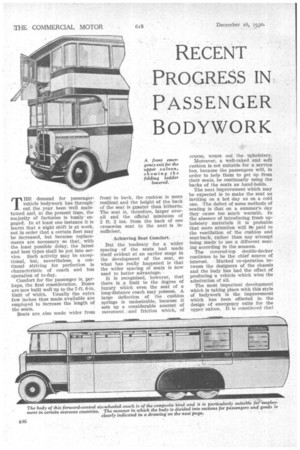RECENT PROGRESS IN PASSENGER BODYWORK
Page 108

Page 109

If you've noticed an error in this article please click here to report it so we can fix it.
Our Bodybuilding Expert Reviews Past Progress in Body Design and Outlines Future Possible Developments, Incorporating Notes on Overseas Vehicles
TBE demand for passengervehicle bodywork has throughout the year been well maintained and, at the present time, the majority of factories is busily engaged. In at least one instance it is learnt that a night shift is at work, not in order that a certain fleet may be increased, but because replacements are necessary so that, with the least possible delay, the latest and best types shall be put into service. Such activity may be exceptional, but, nevertheless, a continual striving for perfection is characteristic of coach and bus operation of to-day.
Comfort for the passenger is, perhaps, the first consideration. Buses are now built well up to the 7-ft. 6-in. limit of width. Usually the extra few inches thus made available are employed to increase the length of the seats.
Seats are also made wider from front to back, the cushion is more resilient and the height of the back of the seat is greater than hitherto. The seat is, therefore, larger overall and the official minimum of 2 ft. 2 ins, from the back of one crosswise seat to the next is insufficient.
Achieving Seat Comfort.
But the tendency for a wider spacing of the seats had made itself evident at an earlier stage in the development of the seat, so what has really happened is that the wider spacing of seats is now used to better advantage.
It is recognized, however, that there is a limit to the degree of luxury which even the seat of a long-distance coach may possess.A large deflection of the cushion springs is undesirable, because it sets up a considerable amount of movement and friction which, of course, wears out the upholstery. Moreover, a well-raked and soft cushion is not suitable for a service bus, because the passengers will, in order to help them to get up from their seats, be continually using the backs of the seats as hand-holds.
The next improvement which may be expected is to make the seat as inviting on a hot day as on a cold one. The defect of some methods of seating is that on a summer's day they cause too much warmth. In the absence of introducing fresh upholstery materials it is probable that more attention will tve paid to the ventilation of the cushion and seat-back, rather than any attempt being made to use a different seating according to the seasons.
The covered-top double-decker continues to be the chief source of interest. Marked co-operation between the designers of the chassis and the body has had the effect of producing a vehicle which wins the• admiration of all.
The most important development which is taking place with this style of bodywork is the improvement which has been effected in the design of emergency exits for the upper saloon. It is considered that in the near future this exit will usuallybe at the front.
The Emergency Exit.
In this position it best fulfils the object of an emergency exit in being ai far away as possible from the normal exit. Moreover, a front opening is generally safer than is a side one. If the special door be in front there is little danger of the passenger leaning against it.
Furthermore, it is in the best position for the mounting of either a fixed or folding ladder. A recent pattern has outside control. both from the driver's cabin and ground level, a feature which has hitherto been absent from many uppersaloon exits.
The bus with more than 14 but not exceeding 20 seats is now to have the same amount of headroom as the larger vehicles. This should not present any great difficulty to the body designer, because the vehicle need not look top-heavy, owing to the fact that a few inches have been added to its height.
A deep skirt panel helps to balance any extra height above the waist line, whilst the apparent height is easily reduced by inereas ing the dome of the roof. This end may be achieved by adopting a clerestory head, or that pattern sometimes called a semi, or false, clerestory, which has a double curve for its cross section.
More attention is now being paid to the question of ventilating the driver's cab. The best type of cab is one which is fully enclosed, rather than one which has only a windscreen and panelling to the waist, or has no door on the off side.
With the increase in the number of overseas coach and bus services it Is hoped that the export of eolu
plete passenger vehicles will keep pace with the number of chassis sent out from this country.
It would appear necessary, therefore, to study ways and means for reducing the cost of bodywork and Its freight, such as by designing it so that it may be exported in a "knocked-down" condition. That is, the body is made up in units which can be packed fiat, either as sets, or as batches.




















































































































































































